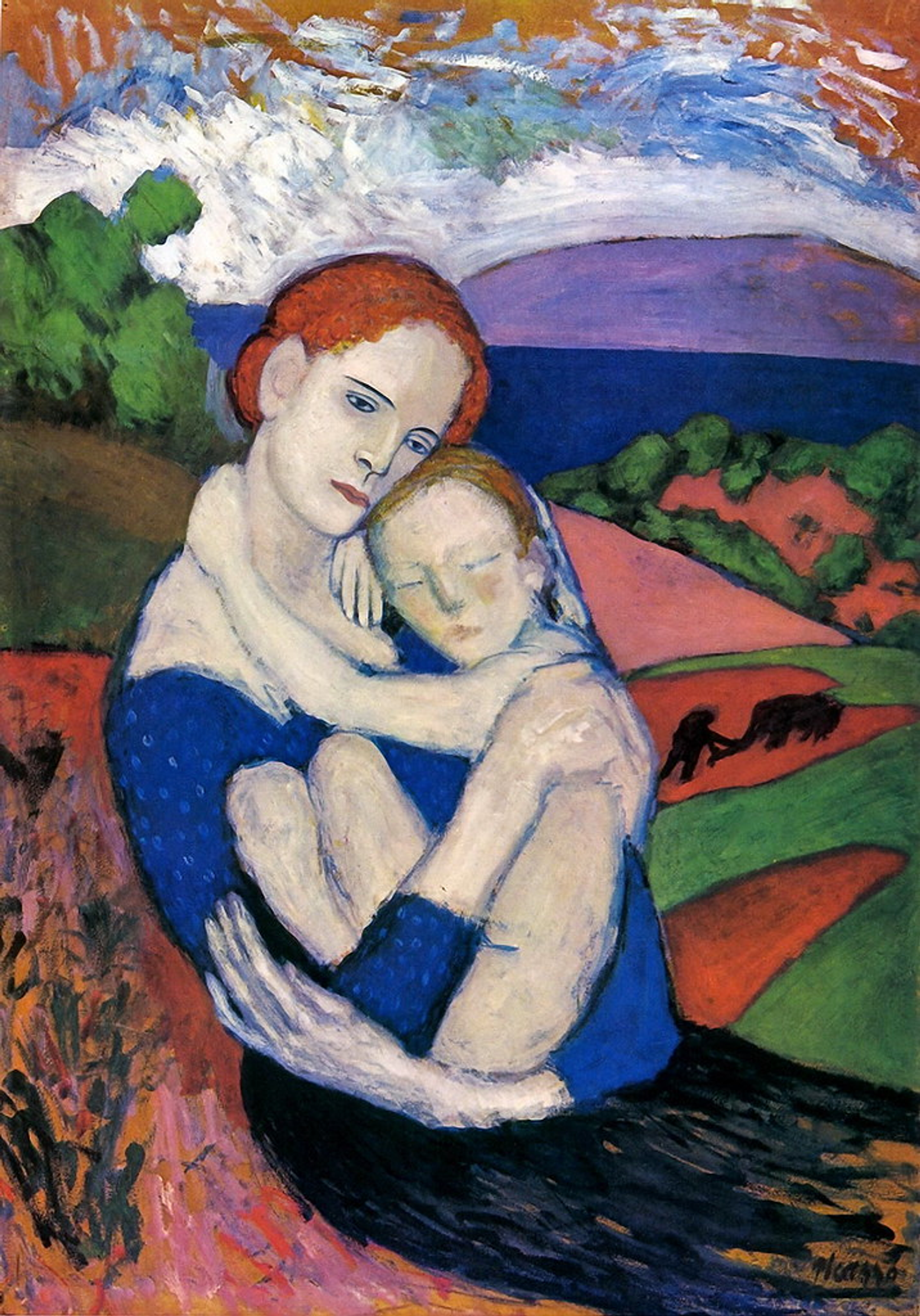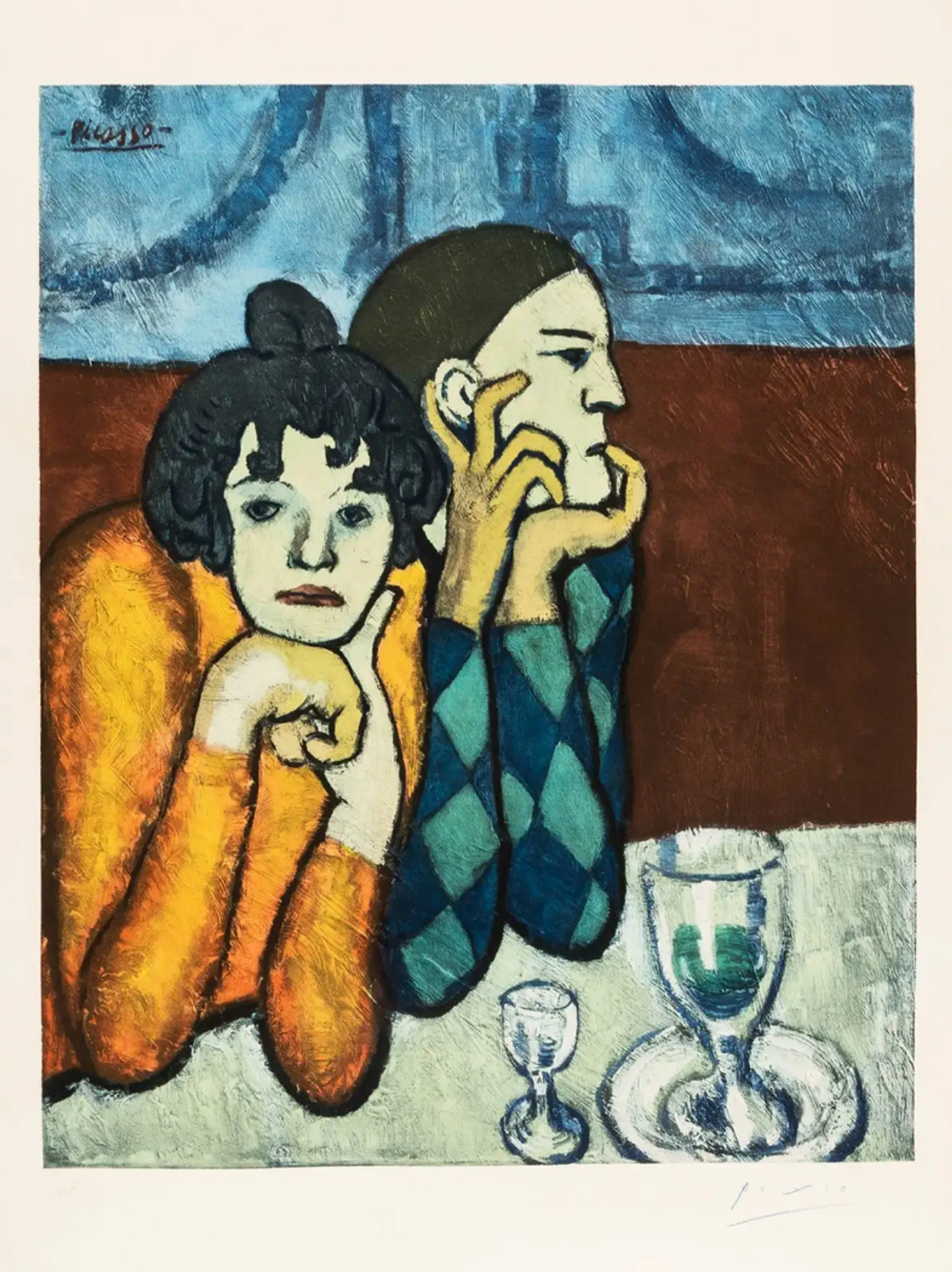 Image © Museum of Modern Art / Les Demoiselles d'Avignon © Pablo Picasso 1907
Image © Museum of Modern Art / Les Demoiselles d'Avignon © Pablo Picasso 1907
Pablo Picasso
160 works
Spanish artist Pablo Picasso was a pivotal figure in the evolution of 20th century art. Picasso's innovative approach to form, colour, and perspective transformed artistic expression and cemented his status as one of the era's most influential artists. Discover how the artist played a crucial role in the development of Modern art by taking a look at his 10 most famous artworks.
 Image © Tate / The Weeping Woman © Pablo Picasso 1937
Image © Tate / The Weeping Woman © Pablo Picasso 1937Weeping Woman (1937)
Weeping Woman, a poignant piece by Picasso from 1937, mirrors the anguish depicted in his larger work, Guernica, which portrays the Spanish Civil War's brutal impact. This particular painting captures the despair of a woman mourning her deceased child, a motif drawn from the aforementioned mural. The artwork, responding to Guernica's bombing by Nazi forces, employs Dora Maar's figure—both an artist and Picasso's companion, who documented Guernica’s creation—as the model for this heart-wrenching depiction of sorrow and loss.
 Image © Museum of Modern Art / Les Demoiselles d'Avignon © Pablo Picasso 1907
Image © Museum of Modern Art / Les Demoiselles d'Avignon © Pablo Picasso 1907Les Demoiselles D’Avignon (1907)
A landmark painting by Picasso, Les Demoiselles d’Avignon dramatically departed from traditional approaches to composition and perspective. Featuring five nude figures with influences from Iberian sculpture and African masks, the painting challenges conventional spatial constructions, using fragmented planes to create a dynamic, unsettling effect. This piece, revealed in Picasso's Paris studio, signifies a monumental shift in modern art, hinting at the burgeoning Cubist movement.
 Image © Museo Nacional Centro de Arte / Guernica © Pablo Picasso 1937
Image © Museo Nacional Centro de Arte / Guernica © Pablo Picasso 1937Guernica (1937)
Guernica, painted by Picasso in 1937, is a monumental work that stands as a powerful statement against war. Displayed in Madrid's Museo Reina Sofía, the painting uses a stark monochrome palette to depict the horrors of the bombing of Guernica during the Spanish Civil War. Through its portrayal of anguished figures, including a gored horse, a bull, screaming women, and a dismembered soldier, the painting conveys the chaos and suffering caused by violence. Symbolic elements, such as a light bulb resembling an eye and a flower growing from a soldier's sword, making the artwork one of the most influential anti-war works in art history.
 Image © The Cleveland Museum of Art / La Vie © Pablo Picasso 1903
Image © The Cleveland Museum of Art / La Vie © Pablo Picasso 1903La Vie (1903)
At just 21, Picasso, grappling with a friend's suicide, dove into the sombre tones which defined his Blue Period. La Vie, painted in 1903, stands as this phase's pinnacle, showcasing themes of despair, isolation, and societal estrangement through a limited, cool palette. The painting, rich in symbolism, has been interpreted as exploring themes from sacred and profane love to the life cycle and the struggles of the working classes.
 Image © The Art Institute of Chicago / The Old Guitarist © Pablo Picasso 1903-04
Image © The Art Institute of Chicago / The Old Guitarist © Pablo Picasso 1903-04The Old Guitarist (1903-04)
Picasso's The Old Guitarist, a pivotal piece from his Blue Period, encapsulates his empathy for the impoverished, influenced by his own financial struggles. This work features an elongated, melancholic figure, reflecting Picasso's fascination with the human condition. It also nods to the stylised forms of El Greco, embedding the painting within a broader Spanish artistic heritage. Through its stark, monochromatic blue tones, Picasso delves into themes of poverty, isolation, and human suffering, making a profound statement on the societal margins of early 20th century Spain.
 Image © WikiArt / Figures At The Seaside © Pablo Picasso 1931
Image © WikiArt / Figures At The Seaside © Pablo Picasso 1931Figures At The Seaside (1931)
In Figures At The Seaside, Picasso explores the dual nature of desire, intertwining ferocity and tenderness within the intimate embrace of two figures. This painting, influenced by his relationship with Dora Maar, depicts the figures with exaggerated, voracious mouths and intertwined bodies, symbolising intense longing and unity with nature. Their sculptural forms blend seamlessly with the coastal landscape, highlighted by golden sunlight and a whimsical touch of domesticity through a beach hut in the background, reflecting a complex portrayal of human passion and its integration with the natural world.
 Image © Artchive / La Rêve © Pablo Picasso 1932
Image © Artchive / La Rêve © Pablo Picasso 1932Le Rêve (1932)
Le Rêve (The Dream) is a captivating portrait of Marie-Thérèse Walter, Picasso's lover, painted in 1932. In this painting, Picasso transforms the classical theme of a seated figure with vibrant colours and voluptuous curves, showcasing his idiosyncratic approach to portraiture. This work reflects both the artist's deep affection for Marie-Thérèse and his innovative exploration of form and colour.
 Image © WikiArt / Jaqueline With Roses © Pablo Picasso 1954
Image © WikiArt / Jaqueline With Roses © Pablo Picasso 1954Jacqueline With Flowers (1954)
Picasso's painting Jacqueline with Flowers is a vibrant homage to his second wife, Jacqueline Roque. This work, part of a larger series, masterfully blends the tenderness of expressive imagery with the dynamic abstraction of Cubism. The painting showcases a geometric deconstruction of Jacqueline's figure, alongside a bouquet of delicate roses, using bold lines and rich, contrasting colours to evoke a sense of vibrancy and movement. This work, which is part of a larger series dedicated to Jacqueline, reveals not only Picasso's profound stylistic evolution but also the complex dynamics of their relationship, marked by intense devotion, control and emotional abuse.
 Image © The Met / At The Lapin Agile © Pablo Picasso 1905
Image © The Met / At The Lapin Agile © Pablo Picasso 1905At The Lapin Agile (1905)
At The Lapin Agile, a seminal work by Picasso from 1905, showcases himself as a Harlequin alongside his lover Germaine Pichot, the muse and tragic figure linked to his friend Casagemas' suicide. Commissioned for the Montmartre cabaret Le Lapin Agile by Frédé Gérard, who is depicted playing guitar, this painting symbolises the bohemian spirit of Paris during that era. It remained the sole permanent exhibition of Picasso's work in Paris at the cabaret from 1905 until its 1912 sale to a German collector.
 Image © MoMA / Girl With A Mandolin © Pablo Picasso 1910
Image © MoMA / Girl With A Mandolin © Pablo Picasso 1910Girl with a Mandolin (1910)
In Girl with a Mandolin, Picasso delves into Analytical Cubism, deconstructing and reassembling the subject into geometric forms, portraying multiple perspectives within a muted, almost monochromatic palette. This method diverges from traditional Western art's focus on central focal points and realistic colouration, favouring an abstract, unified surface that challenges conventional representation. Picasso's innovative use of shape and colour foregrounds the mandolin through its distinct oval silhouette, seamlessly blending the figure with its fragmented backdrop, illustrating Cubism's radical rethinking of form and space.





